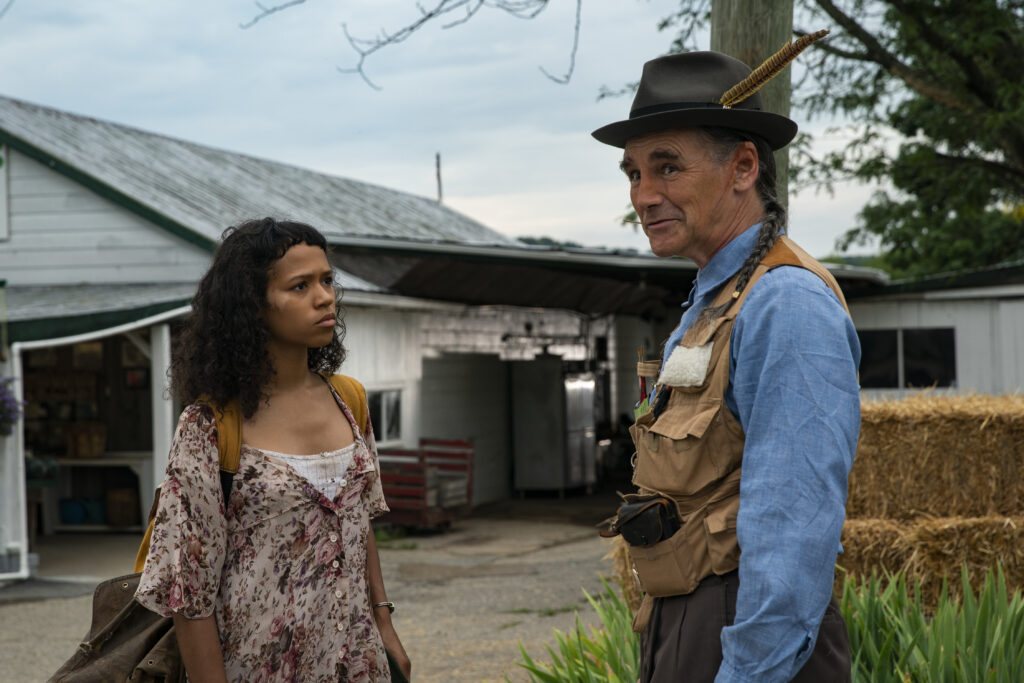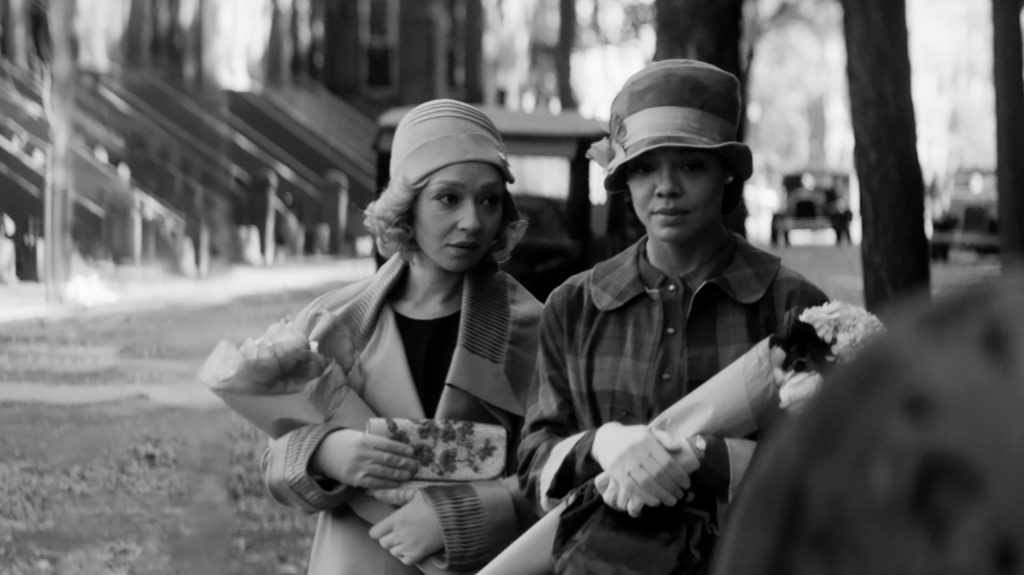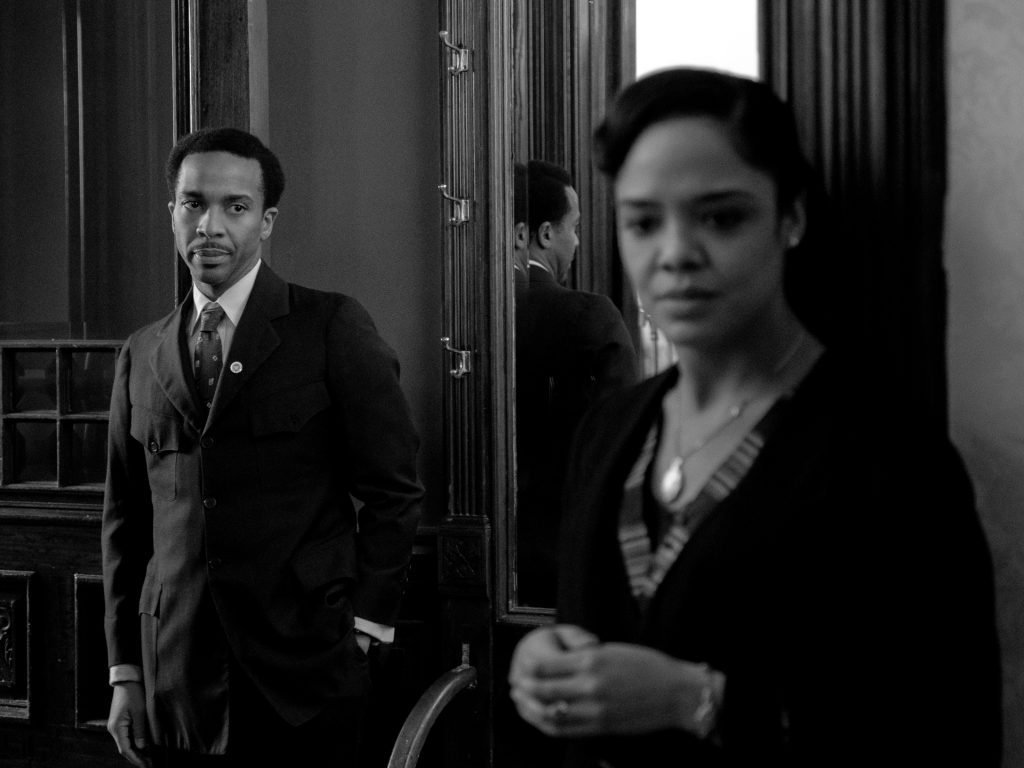November 19, 2022
by Carla Hay

Directed by Luca Guadagnino
Culture Representation: Taking place from 1988 to 1989, in various parts of the United States, the horror film “Bones and All” features a predominantly white cast of characters (with a few black people) representing the working-class and middle-class.
Culture Clash: After being abandoned by her single father, an 18-year-old loner who has a terrible secret (she’s a cannibal) becomes a nomad and falls in love with a young man who’s also a nomadic cannibal, and they go on a road trip where they feed their deadly desires.
Culture Audience: “Bones and All” will appeal primarily to people who are fans of stars Taylor Russell and Timothée Chalamet; filmmaker Luca Guadagnino; and gruesome horror movies that know how to make people squirm.

“Bones and All” is more than just a gory horror film about a cannibal couple. The movie also has clever social commentary about the pitfalls of judging people by outward appearances. Taylor Russell and Timothée Chalamet portray the attractive young couple at the center of the movie, but supporting actor Mark Rylance steals the show with a creepy performance as a middle-aged cannibal with a sinister obsession. Sensitive viewers, be warned: “Bones and All” is not a cute horror romance. This movie has very explicit scenes showing human cannibalism.
Directed by Italian filmmaker Luca Guadagnino, “Bones and All” is his first movie filmed in the United States. Chalamet and Guadagnino previously worked together in 2017’s “Call Me by Your Name,” starring Chalamet in his Oscar-nominated breakout role as a 17-year-old American in Italy who falls in love with a 24-year-old American man who works as a college teaching assistant. “Bones and All” is based on the 2015 novel by Camille DeAngelis. David Kajganich wrote the “Bones and All” adapted screenplay. “Bones and All” had its world premiere at the 2022 Venice International Film Festival in Italy, where Guadagnino won the festival prize for Best Director, while Russell won the Marcello Mastroianni Award, a prize given to emerging actors and actresses.
Taking place in 1988 and 1989, “Bones and All” begins in 1988, in an unnamed U.S. state. Shy and introverted 18-year-old Maren Yearly (played by Russell), who is in her last year of high school, has been invited to a slumber party by a fellow student named Sherry (played by Kendle Coffey), who is a popular student in the school. Maren doesn’t have any close friends at this school, so she’s very surprised by this invitation. Maren tells Sherry that Maren’s overprotective father won’t allow her to go this party, but Sherry suggests that Maren sneak out f Maren’s home at night.
Maren takes this advice and goes to the slumber party, where the female teenagers in attendance are curious to know more about Maren, who is fairly new to the area. Maren and her father Frank Yearly (played by André Holland) have moved around a lot, and they currently live in a trailer in the working-class/poor part of town. Maren recently moved to the area from “the Eastern shore.” She tells the other girls at the party that she doesn’t have any memories of her mother, who abandoned Maren and Frank when Maren was a very young child.
Maren has a big secret about herself that will soon be exposed: She has an intense craving to eat human flesh. The party starts off as festive and friendly. However, Maren’s urges take over, and she suddenly lunges at Sherry and bites off one of Sherry’s fingers. While Sherry and the other partygoers scream in horror, Maren runs back to her home in a panic.
As soon as Frank sees that Maren has come home in a distressed state of mind, he immediately figures out that she snuck out against his wishes and has revealed her cannibal ways. It’s only a matter of time before the police show up at their door. Maren tells Frank that she’s sorry, but he is visibly annoyed and doesn’t want to hear any excuses.
Maren and Frank quickly pack up what they can and leave that night, with no intention of ever going back. Frank and Maren hide out and stay at a motel in Maryland for a few days. It’s not the first time they’ve had to suddenly leave an area because of Maren’s cannibalism.
One morning, Maren wakes up in the motel room and finds out that her father has abandoned her. Frank has left a note saying that he can no longer be around her because he doesn’t know how to deal with her anymore. Frank has also left behind these items for Maren to keep: Maren’s birth certificate, some cash and an audio tape of Frank’s diary-like messages.
In his farewell note, Frank asks Maren to destroy the tape after she’s finished listening to it. In his audio recordings, which Maren plays throughout the movie, Frank tells Maren that when she was 3 years old, she killed her babysitter. Frank covered up that crime and many other cannibal-related crimes committed by Maren. He says after the babysitter’s murder, he changed the family’s surname.
Now completely on her own and homeless, Maren spends the majority of the story as a nomad. Maren is deeply ashamed of being a cannibal, but she also won’t ignore her cannibalistic urges. And now that Maren has her birth certificate, she’s determined to find her mother, whose name is Janelle Kerns (played by Chloë Sevigny).
One night, Maren is out on the street when she meets a soft-spoken, eccentric man named Sully (played by Rylance), who tells her that he’s a cannibal too. Sully says that he knew that Maren is a cannibal because cannibals can smell each other. He also tells Maren that he can tell that Maren has not eaten human flesh in months.
Sully, who is middle-aged and speaks in a Southern drawl, has a very unusual appearance of wearing long, braided hair and a fisherman’s vest. Later, viewers find out that Sully has a gruesome fascination with braided hair: After he eats a human, he takes the dead person’s hair, braids it, and keeps it in a collection.
Knowing that Maren is hungry for human flesh, Sully invites her to go with him to a house where a dying, elderly woman lives alone. Upstairs in her bedroom, the woman is barely conscious. Sully tells Maren that he found the woman in this condition. Sully convinces Maren that if they kill the woman, it will be a mercy killing. And you can imagine what happens next.
Sully tells her a few things about cannibal life that Maren did not know: He says that the most important rule is that cannibals should not eat other cannibals. Sully also warns Maren that her cravings for human flesh will increase as she gets older.
Sully lives in a small, unassuming house. He invites Maren to stay with him for as long as she wants. At first, Sully gives the impression that he wants be a protective father figure to Maren. But it soon becomes apparent that Sully is sexually attracted to Maren and will eventually expect them to be more than friends. Maren knows it too, which is why she secretly gets on a bus to leave the area without saying goodbye to Sully.
The bus is going to Minnesota. Maren’s plan is to eventually travel to Ohio, the state where Maren has her mother’s last-known address. Along the way, she meets another wayward cannibal named Lee (played by Chalamet), who’s a runaway in his late teens. He’s originally from Kentucky and has been living on his own since he was 17. Lee has a truck that he stole from one of his victims: a bachelor named Barry Cook from Centerville, Indiana. Lee invites Maren to travel with him, and they take turns driving.
Lee is not as conflicted as Maren about giving in to his cannibalistic urges. He also tells Maren that he prefers to kill someone who lives alone so he can steal that person’s car and other belongings. As if to justify his crimes, Lee says he usually chooses victims who do something awful to show Lee that these victims “deserve” to be killed.
Lee knew that murder victim Barry lived alone, so he and Maren go to Barry’s home to look for things to steal. Because the vehicles that Lee steals will eventually be reported stolen, he says that’s the motivation he needs to find and kill other people who have cars that he can steal. It’s a vicious cycle that puts Lee and Maren at great risk of getting caught.
Maren isn’t entirely comfortable with what Lee does, but she goes along with everything because she’s lonely and very attracted to him. Lee and Maren become friends and eventually lovers during their extended road trip. During this trip (which takes them to states such as Missouri and Iowa), Lee and Maren experience a lot of highs and lows.
Over time, Lee and Maren share some of their previous cannibal experiences. Lee says that his first cannibal victim as his babysitter. He remembers feeling a like a “superhero’ the first time that he killed and ate her. Maren shares an experience she had when she was 8 years old and went on a camping trip, where a boy was one of her victims.
A memorable part of the movie is when Lee and Maren encounter two other middle-aged cannibals named Jake (played by Michael Stuhlbarg) and Brad (played by David Gordon Green). Over a campfire, Jake and Brad tell Lee and Maren that eating a body, “bones and all,” can give a cannibal an ecstatically powerful feeling like no other. Stuhlbarg, who co-starred with Chalamet in “Call Me by Your Name,” has a much smaller role in “Bones and All,” but his screen time in the movie is still meaningful.
One of the most pivotal parts of “Bones and All” takes place at a carnival, where Lee decides to target a booth worker (played by Jake Horowitz), for reasons that are shown in the movie. This experience is a turning point, because it’s the first time that Maren sees firsthand what Lee is capable of doing. She has to decide if it’s worth staying with him, or if she should continue her journey on her own.
“Bones and All” has stellar acting and a few surprises that make this movie better than the average horror flick. Russell and Chalamet are believable as an emotionally damaged couple who find comfort with each other but are always on edge because of the terrible secrets that they have to keep. Lee and Maren make an interesting pair who are opposites in some ways. Maren is quiet and doesn’t like to call attention to herself, while talkative Lee (with his magenta-streaked hair) has a way about him that practically screams, “Look at me!”
Unlike Maren, whose parents abandoned her, Lee has chosen to abandon his family. Lee has a backstory involving his turbulent relationship with his younger sister Kayla (played by Anna Cobb), who has a lot of resentment toward Lee for leaving the family. Lee confides in Maren that he feels guilty about leaving Kayla behind when he had promised her that he would give her driving lessons.
Chalamet (who is one of the producers of “Bones and All”) is perfectly fine in the role of a troubled young rebel, but it’s the type of character that’s been seen and done in many other movies and TV shows. Russell has the more difficult role, since Maren is very guarded and insecure about her feelings and not a typical wisecracking or sweet ingenue character that would usually be the female love interest in this type of story. Russell capably expresses many emotions through facial expressions and body language because Maren is often afraid of saying what she’s thinking out loud.
And although Sully is not in most of “Bones and All,” his scenes in the movie are what might disturb people the most. Rylance is riveting as this utterly sleazy character, who deliberately disarms people into thinking that he’s just a harmless oddball. On a different level, Lee is a con artist too, because he presents himself as a down-on-his-luck charmer to his victims, who are fooled into thinking that he won’t hurt them.
“Bones and All” has a total running time of 130 minutes, which is a little long for a movie that could have easily been a little under two hours. Although a few scenes in “Bones and All” weren’t entirely necessary, the overall film will still leave a big impression on people. One of the movie’s biggest strengths is that it could have ended in many predictable ways, but it has a twist that many viewers won’t see coming. “Bones and All” goes down a path that will no doubt upset some viewers, but it’s bold enough to not take the easy way out in how to end this grisly and often-heartbreaking story.
Metro Goldwyn Mayer Pictures released “Bones and All” in select U.S. cinemas on November 18, 2022, with an expansion to more U.S. cinemas on November 23, 2022.


